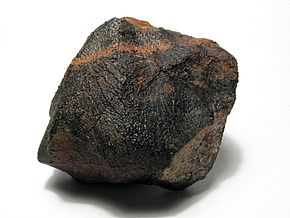This article needs additional citations for verification. (July 2022) |
Millbillillie is a meteorite named after the cattle station in Western Australia on which it fell in October 1960.[1] It is classified as a eucrite achondrite, a kind of stony meteorite.
| Millbillillie | |
|---|---|
 A 175 grams (6.2 oz) individual of the Millbillillie meteorite shower, a eucrite achondrite that fell in Western Australia in 1960. This specimen is approx. 6 centimetres (2.4 in) wide. Note the shiny black fusion crust with flow lines. The chip at lower right allows one to see the light-gray interior. The orange staining at top is a result of weathering, as these stones were not recovered until many years after they fell. | |
| Type | Achondrite |
| Clan | HED meteorites[1] |
| Group | Eucrite[1] |
| Parent body | Possibly 4 Vesta[1] |
| Country | Australia[1] |
| Region | Millbillillie & Jundee Stations, Wiluna district, Western Australia[1] |
| Coordinates | 26°27′S 120°22′E / 26.450°S 120.367°E[1] |
| Observed fall | Yes[1] |
| Fall date | 1960-10[1] |
| Found date | 1970[1] |
| TKW | 330 kilograms (730 lb)[1] |
| Strewn field | Yes[1] |
 77 grams (2.7 oz) oriented specimen of the Millbillillie eucrite meteorite. | |
History
editA fireball was observed "with sparks coming off it" by two stationworkers while they were opening a gate in the boundary fence on a track between Millbillillie and Jundee cattle stations.[1] The object fell on a plain to the north.[1] No search was made at the time but in 1970 and 1971 locals found two stones; Aboriginals have found others since.[1] The largest stone weighed 20 kilograms (44 lb).[1] It and a smaller one of 565 grams (19.9 oz) are held by the Western Australian Museum.[1]
Mineralogy
editThis section is empty. You can help by adding to it. (January 2013) |
Classification
editThis section is empty. You can help by adding to it. (January 2013) |